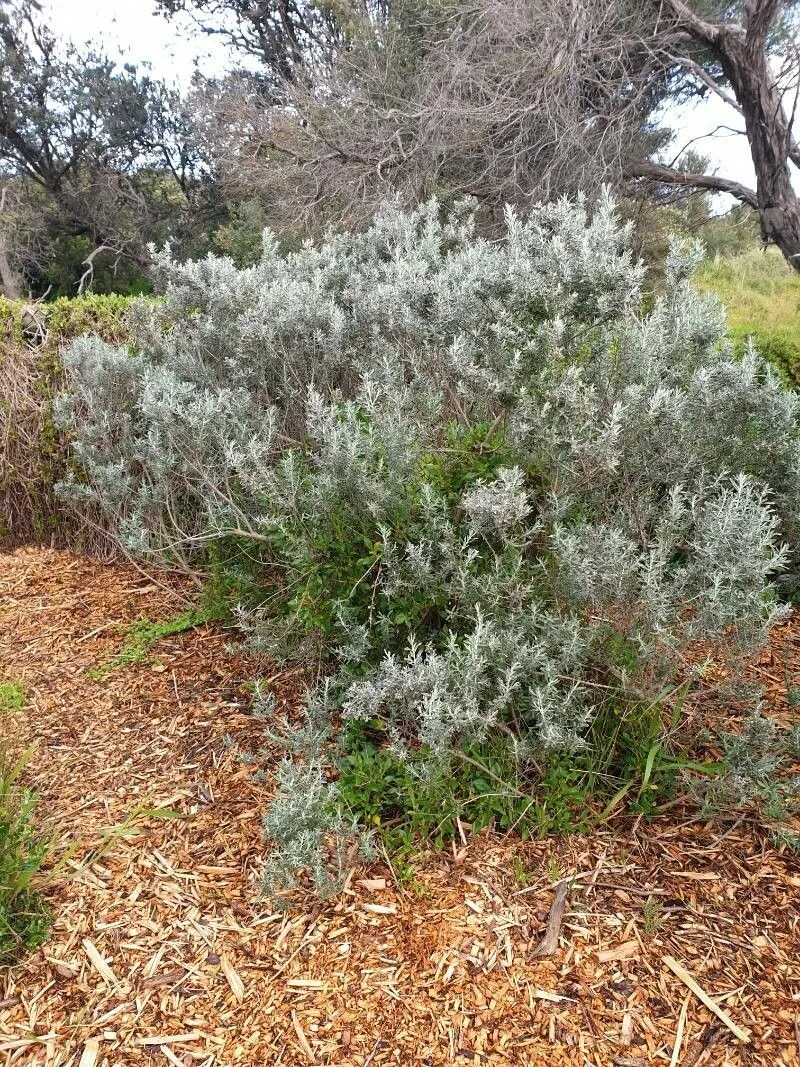
Author: (DC.) F.Muell. ex Benth.
Bibliography: Fl. Austral. 3: 475 (1867)
Year: 1867
Status: accepted
Rank: species
Genus: Olearia
Vegetable: False
Observations: Western Australia
Coast daisy-bush, scientifically known as Olearia axillaris, is a resilient and adaptable shrub that belongs to the Asteraceae family. This species has garnered attention for its unique adaptation to the coastal environments of Western Australia, where it thrives despite the challenging conditions.
First described in Flora Australiensis in 1867 by the Australian botanists (DC.) F. Mueller and George Bentham, Olearia axillaris has a storied presence in the botanical world. It is notable for its ability to flourish along the coast, often seen adorning sandy dunes and rocky outcrops with its hardy appearance.
This evergreen shrub typically reaches up to 1.5 meters in height. It features narrow, oblong, grey-green leaves densely covered in fine, white hairs—a distinctive characteristic that helps to reduce water loss through transpiration, an essential adaptation for survival in arid coastal climates. The leaves are arranged alternately along the stems, giving the plant a somewhat tangled and bushy appearance.
The flowers of the Coast daisy-bush are small, daisy-like, and borne in clusters. They exhibit a mix of white and yellow hues, with the yellow central disc surrounded by white to pale yellow ray florets. These blossoms appear primarily from late winter to spring, attracting a variety of pollinators, including bees and butterflies.
Olearia axillaris plays a crucial ecological role in coastal ecosystems. Its extensive root system helps stabilize sand dunes, preventing erosion and fostering the development of more complex plant communities. Additionally, it provides habitat and food for various native fauna, contributing to the overall biodiversity of its environment.
In horticulture, the Coast daisy-bush is valued for its durability and low maintenance requirements. It is often utilized in coastal landscaping, revegetation projects, and as a component of native plant gardens. Its ability to withstand saline conditions and periods of drought makes it a practical choice for challenging landscapes where other plants might fail.
In summary, Olearia axillaris, or Coast daisy-bush, stands as a testament to the adaptability and resilience of coastal flora. Its ecological significance and horticultural versatility make it a plant of considerable interest and importance in both natural and managed environments.
En: Coast Daisy-bush, Wild Rosemary, Coastal daisybush
: Coast daisy-bush
Taken Apr 26, 2022 by cassie ward (cc-by-sa)
Taken Aug 23, 2022 by Ben (cc-by-sa)
Taken Aug 23, 2022 by Ben (cc-by-sa)
Taken Apr 26, 2022 by cassie ward (cc-by-sa)
Taken Oct 13, 2019 by Gerd Metz (cc-by-sa)
© copyright of the Board of Trustees of the Royal Botanic Gardens, Kew.
Family: Myrtaceae Author: (F.Muell.) K.D.Hill & L.A.S.Johnson Bibliography: Telopea 6: 402 (1995) Year: 1995 Status:…
Family: Rubiaceae Author: Pierre ex A.Froehner Bibliography: Notizbl. Bot. Gart. Berlin-Dahlem 1: 237 (1897) Year:…
Family: Sapindaceae Author: Koidz. Bibliography: J. Coll. Sci. Imp. Univ. Tokyo 32(1): 38 (1911) Year:…
Family: Asteraceae Author: A.Gray Bibliography: Pacif. Railr. Rep.: 107 (1857) Year: 1857 Status: accepted Rank:…
Family: Fabaceae Author: Medik. Bibliography: Vorles. Churpfälz. Phys.-Ökon. Ges. 2: 398 (1787) Year: 1787 Status:…
Family: Aspleniaceae Author: (Cav.) Alston Bibliography: Bull. Misc. Inform. Kew 1932: 309 (1932) Year: 1932…